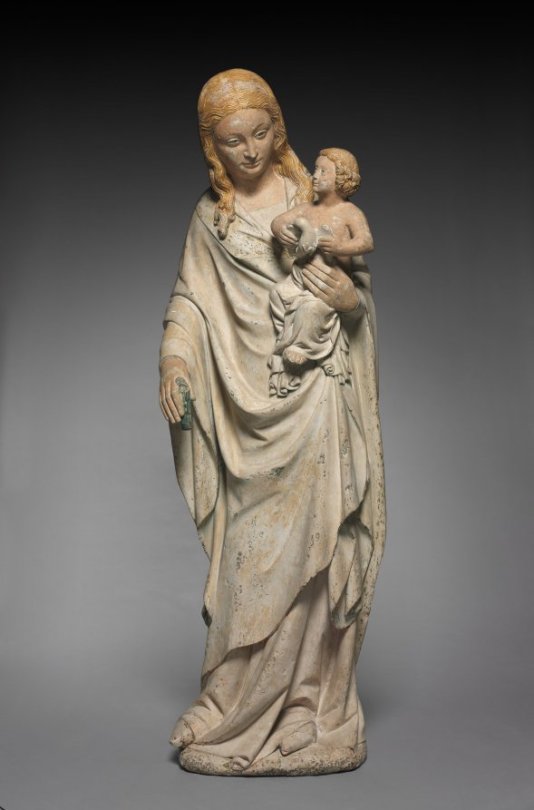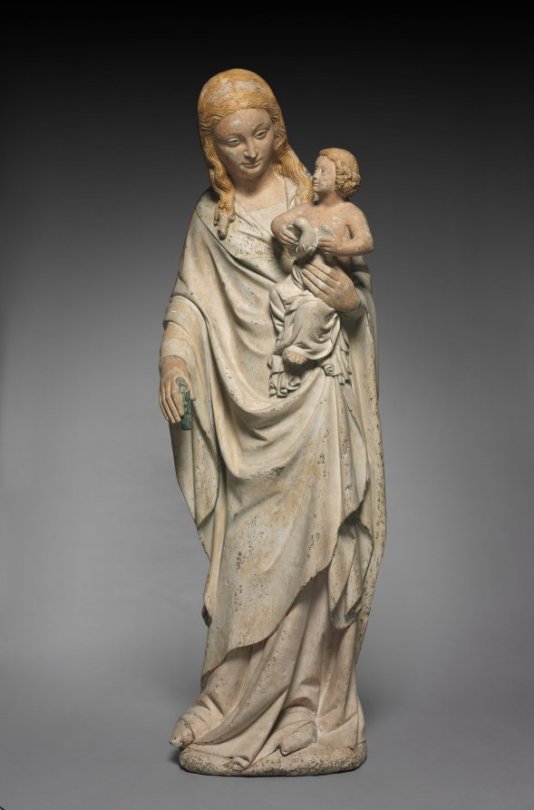#André Beauneveu
Photo

André Beauneveu - Saint Catherine (1380), Church of Our Lady, Kortrijk
Photographed by PMRMaeyaert in 2008
74 notes
·
View notes
Text


Carved Marble Group of Two Addorsed Lions by André Beauneveu (circa 1335–1402), dating from 1364–66.
Originally executed to form part of the tomb of King Charles V of France at the Abbey of St. Denis, they were brought from France in 1802 by the English aristocrat Sir Thomas Neave (1761–1848), and have remained in the same collection ever since. Known to scholars only from an engraving of the 18th century, the emergence of these lions represents a remarkable re-discovery. Celebrating the art of medieval Europe, while simultaneously representing technical brilliance.
Courtesy Alain Truong
52 notes
·
View notes
Photo

Virgin and Child, c. 1385-1390, Cleveland Museum of Art: Medieval Art
The vibrant naturalism of the Virgin’s face and long flowing hair, as well as the deep, rich folds of drapery are characteristic of the work of itinerant artists from the Netherlands who found employment at the Valois courts of France at Paris, Berry, and Burgundy. Their native styles and attention to realistic detail fused with native French artistic traditions toward the end of the 14th century and took root. The original source of this Virgin and Child is unknown, but its style suggests a relationship with similar sculptures made for churches and abbeys of the Central Loire Valley. The additional influence of the style of the sculptor André Beauneveu has also been noted for this sculpture. His commissions were abundant and his influence widespread. The sculptor of this work appears to have had some knowledge of Beauneveu’s work in the Loire region.
Size: Overall: 135.3 x 41.3 x 30.5 cm (53 1/4 x 16 1/4 x 12 in.)
Medium: limestone with traces of polychromy
https://clevelandart.org/art/1962.28
84 notes
·
View notes
Photo

André Beauneveu (circa 1335–1402) A Carved Marble Group Of Two Addorsed Lions, 1364-66 (45 cm wide x 29 cm high x 12 cm deep)
1 note
·
View note
Text
Beauneveu, André. Saint Philip. 1380/5, Bibliothèque Nationale, Paris.

1 note
·
View note
Text
#UnJourUneOeuvre "Tête d'apôtre", Attribué à l'atelier de André BEAUNEVEU, fin du XIVe siècle
► https://t.co/H11DmxbjUN#Sculptures http://pic.twitter.com/0ASM5UFJYH
— Musée du Louvre (@MuseeLouvre) January 14, 2017
0 notes
Photo

Scene of King David from Psalter of Duke Jean of Berry (c. 1402), André Beauneveu
ink on parchment
87 notes
·
View notes
Photo

Virgin and Child, c. 1385-1390, Cleveland Museum of Art: Medieval Art
The vibrant naturalism of the Virgin’s face and long flowing hair, as well as the deep, rich folds of drapery are characteristic of the work of itinerant artists from the Netherlands who found employment at the Valois courts of France at Paris, Berry, and Burgundy. Their native styles and attention to realistic detail fused with native French artistic traditions toward the end of the 14th century and took root. The original source of this Virgin and Child is unknown, but its style suggests a relationship with similar sculptures made for churches and abbeys of the Central Loire Valley. The additional influence of the style of the sculptor André Beauneveu has also been noted for this sculpture. His commissions were abundant and his influence widespread. The sculptor of this work appears to have had some knowledge of Beauneveu’s work in the Loire region.
Size: Overall: 135.3 x 41.3 x 30.5 cm (53 1/4 x 16 1/4 x 12 in.)
Medium: limestone with traces of polychromy
https://clevelandart.org/art/1962.28
12 notes
·
View notes
Photo

Virgin and Child, c. 1385-1390, Cleveland Museum of Art: Medieval Art
The vibrant naturalism of the Virgin’s face and long flowing hair, as well as the deep, rich folds of drapery are characteristic of the work of itinerant artists from the Netherlands who found employment at the Valois courts of France at Paris, Berry, and Burgundy. Their native styles and attention to realistic detail fused with native French artistic traditions toward the end of the 14th century and took root. The original source of this Virgin and Child is unknown, but its style suggests a relationship with similar sculptures made for churches and abbeys of the Central Loire Valley. The additional influence of the style of the sculptor André Beauneveu has also been noted for this sculpture. His commissions were abundant and his influence widespread. The sculptor of this work appears to have had some knowledge of Beauneveu’s work in the Loire region.
Size: Overall: 135.3 x 41.3 x 30.5 cm (53 1/4 x 16 1/4 x 12 in.)
Medium: limestone with traces of polychromy
https://clevelandart.org/art/1962.28
6 notes
·
View notes
Photo

Virgin and Child, 0, Cleveland Museum of Art: Medieval Art
The vibrant naturalism of the Virgin’s face and long flowing hair, as well as the deep, rich folds of drapery are characteristic of the work of itinerant artists from the Netherlands who found employment at the Valois courts of France at Paris, Berry, and Burgundy. Their native styles and attention to realistic detail fused with native French artistic traditions toward the end of the 14th century and took root. The original source of this Virgin and Child is unknown, but its style suggests a relationship with similar sculptures made for churches and abbeys of the Central Loire Valley. The additional influence of the style of the sculptor André Beauneveu has also been noted for this sculpture. His commissions were abundant and his influence widespread. The sculptor of this work appears to have had some knowledge of Beauneveu’s work in the Loire region.
Size: Overall: 135.3 x 41.3 x 30.5 cm (53 1/4 x 16 1/4 x 12 in.)
Medium: limestone with traces of polychromy
https://clevelandart.org/art/1962.28
0 notes